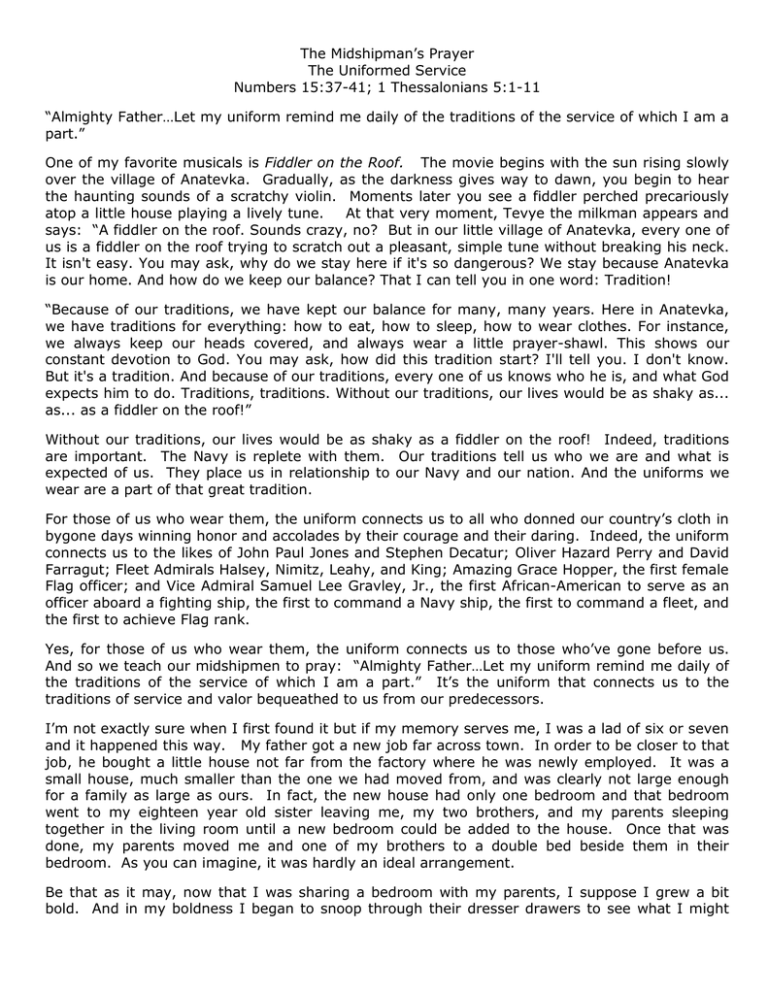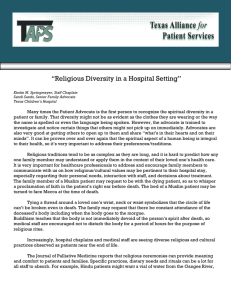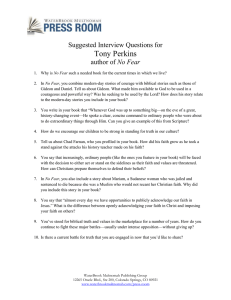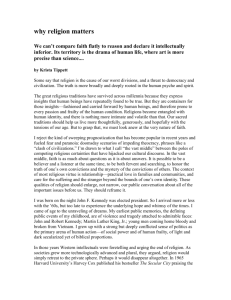The Midshipman’s Prayer The Uniformed Service Numbers 15:37-41; 1 Thessalonians 5:1-11
advertisement

The Midshipman’s Prayer The Uniformed Service Numbers 15:37-41; 1 Thessalonians 5:1-11 “Almighty Father…Let my uniform remind me daily of the traditions of the service of which I am a part.” One of my favorite musicals is Fiddler on the Roof. The movie begins with the sun rising slowly over the village of Anatevka. Gradually, as the darkness gives way to dawn, you begin to hear the haunting sounds of a scratchy violin. Moments later you see a fiddler perched precariously atop a little house playing a lively tune. At that very moment, Tevye the milkman appears and says: “A fiddler on the roof. Sounds crazy, no? But in our little village of Anatevka, every one of us is a fiddler on the roof trying to scratch out a pleasant, simple tune without breaking his neck. It isn't easy. You may ask, why do we stay here if it's so dangerous? We stay because Anatevka is our home. And how do we keep our balance? That I can tell you in one word: Tradition! “Because of our traditions, we have kept our balance for many, many years. Here in Anatevka, we have traditions for everything: how to eat, how to sleep, how to wear clothes. For instance, we always keep our heads covered, and always wear a little prayer-shawl. This shows our constant devotion to God. You may ask, how did this tradition start? I'll tell you. I don't know. But it's a tradition. And because of our traditions, every one of us knows who he is, and what God expects him to do. Traditions, traditions. Without our traditions, our lives would be as shaky as... as... as a fiddler on the roof!” Without our traditions, our lives would be as shaky as a fiddler on the roof! Indeed, traditions are important. The Navy is replete with them. Our traditions tell us who we are and what is expected of us. They place us in relationship to our Navy and our nation. And the uniforms we wear are a part of that great tradition. For those of us who wear them, the uniform connects us to all who donned our country’s cloth in bygone days winning honor and accolades by their courage and their daring. Indeed, the uniform connects us to the likes of John Paul Jones and Stephen Decatur; Oliver Hazard Perry and David Farragut; Fleet Admirals Halsey, Nimitz, Leahy, and King; Amazing Grace Hopper, the first female Flag officer; and Vice Admiral Samuel Lee Gravley, Jr., the first African-American to serve as an officer aboard a fighting ship, the first to command a Navy ship, the first to command a fleet, and the first to achieve Flag rank. Yes, for those of us who wear them, the uniform connects us to those who’ve gone before us. And so we teach our midshipmen to pray: “Almighty Father…Let my uniform remind me daily of the traditions of the service of which I am a part.” It’s the uniform that connects us to the traditions of service and valor bequeathed to us from our predecessors. I’m not exactly sure when I first found it but if my memory serves me, I was a lad of six or seven and it happened this way. My father got a new job far across town. In order to be closer to that job, he bought a little house not far from the factory where he was newly employed. It was a small house, much smaller than the one we had moved from, and was clearly not large enough for a family as large as ours. In fact, the new house had only one bedroom and that bedroom went to my eighteen year old sister leaving me, my two brothers, and my parents sleeping together in the living room until a new bedroom could be added to the house. Once that was done, my parents moved me and one of my brothers to a double bed beside them in their bedroom. As you can imagine, it was hardly an ideal arrangement. Be that as it may, now that I was sharing a bedroom with my parents, I suppose I grew a bit bold. And in my boldness I began to snoop through their dresser drawers to see what I might find. And that’s when I found it. Folded neatly in the top drawer of a tall dresser was my father’s uniform from World War 2. You see, my father was a signalman in World War 2 and served aboard the U.S.S. Philadelphia. He participated in the invasions of North Africa, Sicily, Salerno, Anzio, and southern France. He rarely talked about his experience but as I grew older I learned enough to know that he saw all the combat he ever hoped to see and didn’t want any of his children to experience what he had experienced during the war. Despite the fact that he didn’t say much about his naval service, I grew up wanting to follow in his steps. I wonder now if perhaps the first seeds of such an interest were initially sown when I first found his uniform tucked neatly away and learned that my father had been a Sailor in World War 2. In any event, after I donned the cloth of my country, my father opened up and began to share sea stories he never shared with me before. Suddenly we shared a common bond. We were part of a shared tradition. And when he died, his uniform was passed down to me to keep the memory alive. Yes, for those of us who wear them, the Navy uniform connects us to those who’ve gone before us. And so we teach our Midshipmen to pray: “Almighty Father…Let my uniform remind me daily of the traditions of the service of which I am a part.” But for those who have never worn a uniform, this petition may seem meaningless. And yet, perhaps people of faith are called to uniformed service as well. Perhaps people of faith are called to wear a uniform that identifies them with the great traditions of their religion. I know this is true for our Jewish friends and neighbors. Just a few days ago I was walking across the yard when I ran into a family of Orthodox Jews visiting the Academy grounds. I stopped to greet them and, during the course of our conversation, I noticed some tassels dangling from their garments. Those tassels are prescribed by God in Numbers 15:37-41. The Bible says: “The Lord said to Moses: ‘Speak to the Israelites, and tell them to make fringes on the corners of their garments throughout their generations and to put a blue cord on the fringe at each corner. You have the fringe so that, when you see it, you will remember all the commandments of the Lord and do them, and not follow the lust of your own heart and your own eyes. So you shall remember and do all my commandments, and you shall be holy to your God. I am the Lord your God, who brought you out of the land of Egypt, to be your God: I am the Lord your God.’” (NRSV) Here God tells the Jews to wear tassels to remind them of who they are and whose they are and what is expected of them. According to Rabbi Sherwin, who serves on our staff, there are 613 knots and loops in those tassels to remind the Jewish people of the 613 commandments set forth in the Torah. Rabbi Sherwin tells me there are 248 positive commandments, “Thou Shalls,” representing all the bones in the body, and those positive commandments remind us that we are to obey God with every fiber of our being. Deducting the 248 positive commandments from the total of 613 leaves 365 negative commandments, “Thou Shall Nots,” and those negative commandments remind us that we are to refrain from sin every day of every year of our entire lives. It’s a beautiful interpretation and I admire the practice of our Jewish friends who wear a uniform to remind them of the great Torah tradition to which they belong – and the God of that tradition to whom they owe absolute obedience. But what about us? What about Christians? Perhaps we also belong to God’s uniformed service. Perhaps we are commanded to wear a uniform that connects us to the great traditions of our faith – a uniform that identifies us just as surely as a Navy uniform identifies a Sailor and tassels identify a Jew. Is there such a uniform? There is! In 1 Thessalonians 5:1-11, the apostle Paul writes about the Day of the Lord. The Day of the Lord refers to the Second Coming of Jesus Christ to judge the living and the dead. In verse 2 Paul tells us that Christ will come unexpectedly like a thief in the night, but he assures us in verses 4-8 that the Second Coming will not catch us by surprise if we stay sober and alert and are dressed in the proper uniform when Jesus comes again. What is that uniform? The answer is found in 1 Thessalonians 5:8 where Paul says, “…let us be sober, and put on the breastplate of faith and love, and for a helmet the hope of salvation.” (NRSV) Faith, love, and hope - these are the elements that comprise the Christian’s uniform. should be able to look at us and see these things. People My friend, are you wearing the uniform of faith? According to Hebrews 11:1 and 6, “Faith is the assurance of things hoped for, the conviction of things not seen…without faith it is impossible to please God, for whoever would approach him must believe that he exists and that he rewards those who seek him.” (NRSV) What is faith? Faith is believing that God exists. But it’s more than that. The devils believe that much and tremble. (James 2:19) No, faith is more than believing that God exists. It is believing not only that he exists but that he also rewards those who diligently seek him. And how do you know whether or not you are seeking him? It will show in what you do. The eleventh chapter of Hebrews makes this plain. For after giving the definition of faith, Hebrews goes on to provide a long list of saints who demonstrated their faith by their actions – saints like Abel, Enoch, and Noah; Abraham, Isaac, and Jacob; Joseph, Moses, and others who demonstrated their faith by their works and their deeds. My friend, are you wearing the uniform of faith? When people look at you do they see someone who truly believes that God exists? Do they see someone who truly believes that God rewards those who seek him? And do they see someone who is demonstrating their faith by what they do on a daily basis? This brings us to the second piece of the Christian’s uniform: love. In 1 Thessalonians 5:8 Paul tells us to put on the breastplate of faith and love. Notice how these two articles are joined together by the apostle Paul. They are all part of the same breastplate. Why? Because faith and love – love for God and love for neighbor - always go hand in hand. If you truly believe in God then you will love him with all of your heart, soul, mind and strength, and you will love your neighbor as yourself. (Matthew 22:34-40) Yes, faith and love go hand in hand. That’s why James 2:14-17 says, “What good is it, my brothers and sisters, if you say you have faith but do not have works? Can faith save you? If a brother or sister is naked and lacks daily food, and one of you says to them, “Go in peace; keep warm and eat your fill,” and yet you do not supply their bodily needs, what is the good of that? So faith by itself, if it has no works, is dead.” (NRSV) My friend, are you wearing the uniform of faith? And are you wearing the uniform of love? When people look at you do they see someone who is head over heels in love with God and actively involved in loving others? Finally, are you wearing for a helmet the hope of salvation? What is the hope of salvation? It is the hope that comes to those who have accepted the saving help of Jesus Christ. You see, if we have accepted the saving help of Jesus Christ then we should be filled with hope! We should be filled with hope because we know our sins are forgiven. We should be filled with hope because we know we’re accepted by God. We should be filled with hope because we know that Jesus is with us to help us when we need him. And we should be filled with hope because we know that he has prepared a place for us in glory! Knowing all of this, how can we be anything but hopeful? My friend, are you wearing for a helmet the hope of salvation? When people look at you do they see someone who is full of hope? They should! It is your birthright as a Christian. My friend, if you’re a Christian then you’re a part of God’s uniformed service. And as part of God’s uniformed service, you are to dress yourself in faith, love, and hope! God supplies them. All are gifts. But you must put them on. Are you wearing them? When Christ comes again, will he find you in uniform? Will you pass his inspection? You think about that. So let us pray: “Almighty Father…Let my uniform remind me daily of the traditions of Thy service of which I am a part.” Amen. Discussion Questions: 1. In the Fiddler on the Roof, Tevye says, “Without our traditions, our lives would be as shaky as a fiddler on the roof!” What are some of the traditions that you find most meaningful in your family, your work, and/or your life of faith? 2. In Matthew 15:1-9, Jesus criticizes some of the religious traditions of his time. What were those traditions and how can religious traditions sometimes undermine our faith? 3. Read 2 Thessalonians 2:13-3:15. In 2 Thessalonians 2:15, Paul told the Thessalonian Christians to hold fast to the traditions that he taught them by word of mouth and in written letters. In 2 Thessalonians 3:6-7 he spoke of the traditions he passed on to the Thessalonians by his example. What were those traditions and why were they important? What traditions have been passed down to you by word of mouth or example that strengthen, rather than weaken, your faith? 4. In the Midshipman’s prayer we pray to God saying, “Let my uniform remind me daily of the traditions of the service of which I am a part.” The uniform is an outward and visible symbol that connects those who wear it with military service, the country at large, and the citizenry of that country. What outward and visible signs and/or symbols connected you with the Christian faith, God’s service, and his Church? 5. In 1 Thessalonians 5:8 Paul says, “…let us be sober, and put on the breastplate of faith.” According to Hebrews 11:1 & 6, faith is believing that God exists and that he rewards those who seek him. How did you first come to faith? How have you experienced God’s rewards of faith? 6. In 1 Thessalonians 5:8 Paul says, “…let us be sober, and put on the breastplate of love.” According to Matthew 22:34-40 and James 2:14-17, true faith results in love for God and loving service of others. How has your faith inspired you to love God and neighbor and what concrete acts demonstrate that love? 7. In 1 Thessalonians 5:8 Paul says, “…let us be sober, and put on…for a helmet the hope of salvation.” The hope of salvation is the kind of hope that comes to those who have accepted the saving help of Jesus Christ. How has Jesus helped you to be hopeful?






